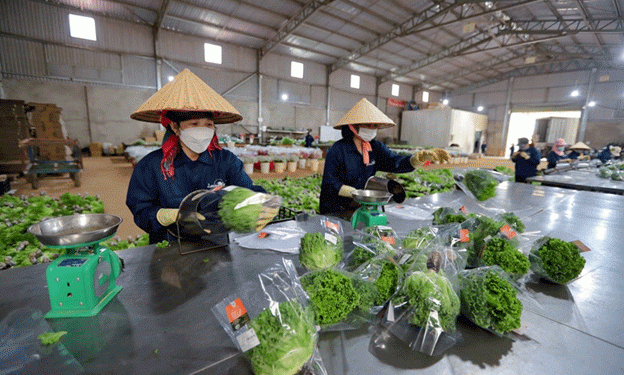Hydroponic farming, a method that allows for growing plants without soil by using nutrient-rich water, is gaining traction among farmers in Lâm Đồng province. This innovative approach has demonstrated significant advantages over traditional farming, particularly in water conservation and economic efficiency. Two successful examples of hydroponic farming in Lâm Đồng are the family-run farm of Tô Quan Dũng and the Meli Green Farm Cooperative, both of which have achieved remarkable results by implementing advanced hydroponic systems.
Tô Quan Dũng’s Success Story in Hydroponics
Nearly two years ago, Tô Quan Dũng, a farmer in Đạ Sar, Lạc Dương district, began cultivating 1.5 hectares of vegetables, roots, and fruits using hydroponics combined with high technology. Initially, Dũng faced challenges with nutrient mixing and design flaws in the hydroponic system, such as clogged irrigation lines. However, by researching successful hydroponic models and making necessary adjustments, he overcame these difficulties.
Today, Dũng has perfected his hydroponic system and specializes in growing two types of lettuce: Crispenya and Crispyano, commonly known as “glass lettuce.” His success has enabled him to establish a company to expand production and market reach. Currently, Dũng exports his high-quality lettuce to Japan, Singapore, and South Korea, with the Korean market alone receiving around 100 tons over two months, generating substantial profits.
Meli Green Farm Cooperative: A Model for Local Agriculture
In Lâm Hà district, Meli Green Farm Cooperative, located in Buôn Chuối, Mê Linh commune, has become a local leader in hydroponic farming. The cooperative has built over 5,000 square meters of greenhouses, housing 70,000 hydroponically grown vegetables. These greenhouses are equipped with Israeli technology, featuring automated systems that ensure optimal nutrient delivery and growth conditions.
Every day, Meli Green Farm Cooperative harvests and sells between 2,000 and 2,500 hydroponic vegetables, weighing approximately 500 to 800 kilograms, at an average price of 6,000 to 7,000 VND per plant (around 28,000 to 32,000 VND per kilogram). The cooperative’s careful planning and high-quality produce have enabled it to supply vegetables to supermarkets in Ho Chi Minh City, as well as several provinces in the Central Highlands and the Mekong Delta. In addition, Meli Green Farm is preparing to expand its market to Japan, South Korea, and Singapore.
Hydroponics: Water-Saving and Economically Efficient
Hydroponic farming in Lâm Đồng is not only profitable but also environmentally sustainable. According to Master Ngô Xuân Chinh, Director of the Center for Agricultural Technology Transfer Research under the Southern Institute of Agricultural Science and Technology, the province currently has over 300 hectares of recirculating hydroponic systems. These systems save up to 40% of water compared to traditional soil-based farming. Additionally, many farms in the region have implemented rainwater harvesting solutions, utilizing collected water for their hydroponic operations.
Beyond water conservation, hydroponic farming also shortens the production cycle by 20 days to a month compared to conventional farming methods. This acceleration reduces the post-harvest loss rate to below 10%, compared to the 30% loss rate typical in traditional farming. Since hydroponic crops are grown in greenhouses, they are well-protected from pests, eliminating the need for chemical pesticides and resulting in higher market prices for the produce.
The adoption of hydroponic farming in Lâm Đồng province is a testament to the potential of modern agricultural practices to enhance sustainability and profitability. Farmers like Tô Quan Dũng and the members of Meli Green Farm Cooperative have not only improved their economic standing but also contributed to the region’s agricultural innovation. With continued investment in technology and support from local authorities, hydroponic farming is set to play a pivotal role in the future of agriculture in Lâm Đồng.











